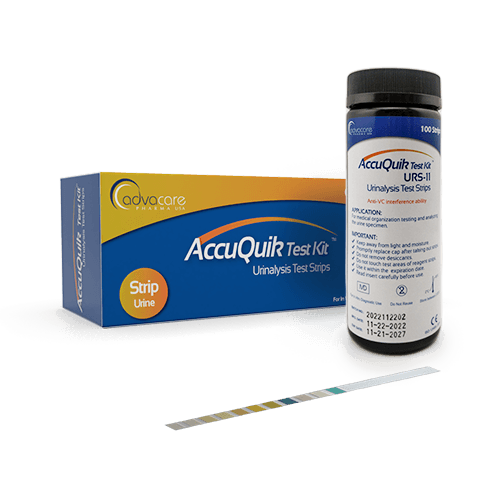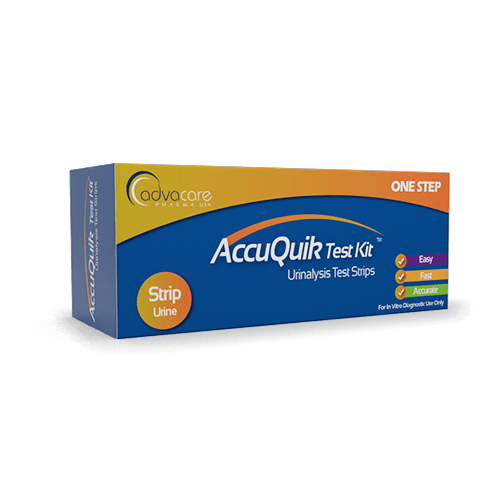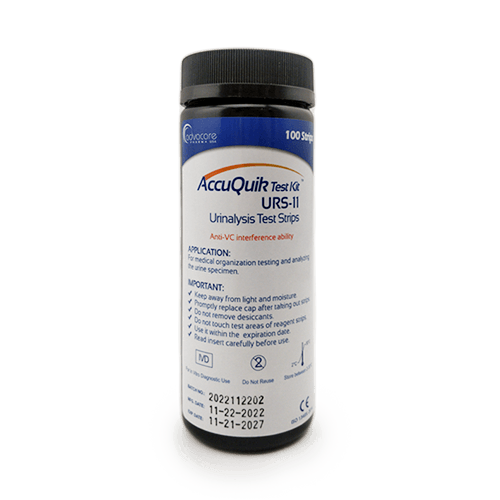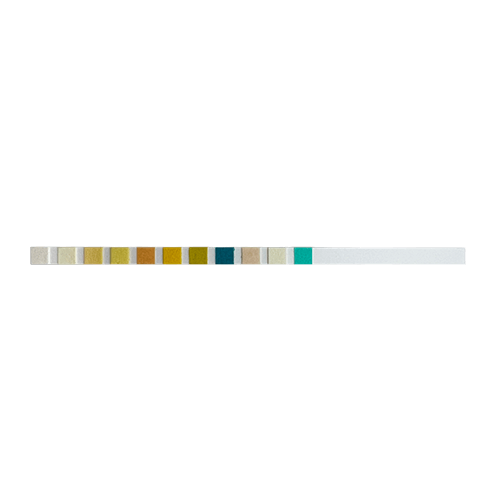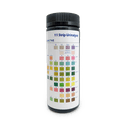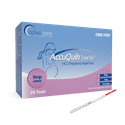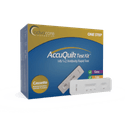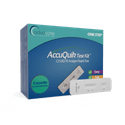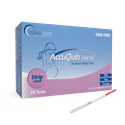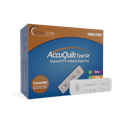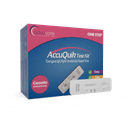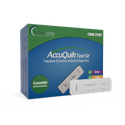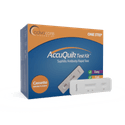- Home›
- Medical Devices›
- Diagnostic Detection Devices›
- Rapid Test Kits (RDT)›
- Urine Test Strips
Urine Test Strips
Specimen
Reagent
Form
Packaging
What are Urine Test Strips?
Urine Test Strips are medical diagnostic tools used to provide a qualitative analysis of the composition of urine. Each dipstick is produced to test from one to a combination of up to 14 markers, including leukocytes, nitrite, urobilinogen, protein, pH, hemoglobin, specific gravity, ketone, bilirubin, and glucose.
Regular urinalysis is a basic tool for the screening and diagnosis of many conditions, including diabetes, chronic kidney disease, and proteinuria.
The urine dipsticks are based on chromatic immunoassay testing. Each test strip contains reagents that will produce a visible change which can be compared with a chromatic scale.
AdvaCare Pharma manufactures Urine Test Strips in ISO and CE-certified facilities located in strategic positions across the world. Each facility undergoes routine inspections to ensure adherence to international standards and regulatory compliance.
Product Specifications
Specimen
Urine specimens can be collected at any time of the day using a clean and dry container. A clean and dry container helps maintain the integrity of the specimen, which helps to ensure accurate test results. There is no specific requirement for the timing of urine sample collection, allowing for flexibility in the testing process.
Reagent
URS-1G (GLU): This urine dipstick is designed to detect glucose in a urine sample, which can assist in monitoring blood sugar levels in individuals with diabetes or other metabolic disorders. By analyzing the concentration of glucose in the urine, the dipstick provides insights into glycemic control and provide better diabetes management.
URS-1K (KET): This urine dipstick is designed to detect ketones in a urine sample. Ketones are byproducts of fat metabolism which can accumulate if the body is using fat for energy instead of glucose. The presence of ketones in a urine specimen can indicate conditions such as diabetic ketoacidosis or starvation.
URS-1P (PRO): This urine dipstick is designed for the detection of protein in a urine sample, which can help identify proteinuria (the presence of excessive protein in the urine). Proteinuria can be an indication of some types of kidney conditions. By analyzing the protein levels in urine, these dipsticks can be used to assess and monitor renal health.
URS-2K (GLU/KET): This urine dipstick has been designed to combine reagents for the simultaneous analysis of glucose and ketone testing in a single strip. This dipstick is particularly useful for individuals with diabetes or for those who are following a ketogenic diet, as it provides a more comprehensive assessment of overall metabolic health.
URS-2P (GLU/PRO): This dual-function dipstick allows for the simultaneous evaluation of both glucose and protein levels, which can aid in diabetes management and the detection of potential kidney abnormalities. It offers a convenient and reliable method for individuals and healthcare professionals to monitor both glucose and protein excretion in urine.
URS-3 (GLU/PRO/pH): This multiparameter urine dipstick is designed with reagents to detect glucose, protein, and pH levels in a urine sample. It allows for quick and convenient analysis of these key parameters, which can aid many individuals and healthcare professionals in managing diabetes, identifying proteinuria, and monitoring urinary pH levels.
URS-4B (GLU/PRO/pH/BLD): This style of urine test contains comprehensive urine test strips with reagents for detecting glucose, protein, pH, and blood in urine samples. It allows for the simultaneous evaluation of these parameters, which can help provide insights into diabetes management, kidney health, and potential urinary tract infections or abnormalities.
URS-4S (GLU/PRO/pH/SG): The URS-4S urine dipstick is designed to detect and analyze glucose, protein, pH, and specific gravity (SG) levels in urine samples. This multiparameter urine testing strip can provide a comprehensive assessment of these key urine parameters, aiding in the evaluation of diabetes control, kidney function, and hydration status.
URS-5K (BLD/KET/GLU/PRO/pH): The URS-5K urine test strip is a comprehensive test strip that detects blood, ketones, glucose, protein, and pH levels in a single urine sample. This dipstick allows for the simultaneous analysis of these key parameters, which can provide information for diabetes control, detecting ketosis, assessing kidney function, and evaluating urinary pH levels. It offers a convenient and efficient method for evaluating multiple urine parameters in a single test.
URS-6L (BLD/KET/GLU/PRO/LEU/BIL): The URS-6L urine dipstick is designed to analyze blood, ketones, glucose, protein, leukocytes, and bilirubin in urine samples. This multiparameter urine test strip offers a comprehensive assessment of these key urine parameters, which helps provide valuable information for monitoring diabetes control, detecting ketosis, assessing kidney function, and evaluating potential urinary tract infections or liver conditions.
URS-7 (URO/BLD/KET/GLU/PRO/pH/BIL): The URS-7 urine dipstick is a comprehensive test strip with reagents for the detection of urobilinogen, blood, ketones, glucose, protein, pH, and bilirubin in urine samples. This multiparameter dipstick provides valuable insights into liver function, kidney health, diabetes control, and potential urinary tract infections or abnormalities. It offers a convenient and reliable method for evaluating multiple urine parameters in a single test.
URS-8 (URO/BLD/KET/GLU/PRO/pH/BIL/NIT): The URS-8 urine testing strip is designed with reagents for urobilinogen, blood, ketones, glucose, protein, pH, bilirubin, and nitrite levels in a urine sample. This multiparameter dipstick offers a comprehensive evaluation of key urine parameters, providing information for the assessment of liver function, kidney health, and diabetes in a single test.
URS-9 (URO/BLD/KET/GLU/PRO/pH/BIL/NIT/SG): The URS-9 urine test strip is a comprehensive test strip that includes reagents for the detection of urobilinogen, blood, ketones, glucose, protein, pH, bilirubin, nitrite, and specific gravity (SG) levels in a urine sample. It offers a convenient and reliable method for evaluating multiple urine parameters in a single test.
URS-10 (URO/BLD/KET/GLU/PRO/pH/BIL/NIT/SG/LEU): This multiparameter urine dipstick has been designed with reagents for the detection of urobilinogen, blood, ketones, glucose, protein, pH, bilirubin, nitrite, specific gravity (SG), and leukocytes in a sample of urine. This test offers a convenient and reliable method for evaluating multiple urine parameters in a single, convenient test.
URS-11 (URO/BLD/KET/GLU/PRO/pH/BIL/NIT/SG/LEU/VC): The URS-11 urine test strip is a comprehensive dipstick with reagents that detects urobilinogen, blood, ketones, glucose, protein, pH, bilirubin, nitrite, specific gravity (SG), leukocytes, and vitamin C (VC) levels in a urine sample. This multiparameter test offers a comprehensive assessment of these key urine parameters in a single test.
URS-14 (URO/BLD/KET/GLU/PRO/pH/BIL/NIT/SG/LEU/Vc/Ca/MALB/Cr): The URS-14 urine dipstick s a comprehensive dipstick with reagents that detects urobilinogen, blood, ketones, glucose, protein, pH, bilirubin, nitrite, specific gravity (SG), leukocytes, vitamin C (VC), calcium (Ca), microalbumin (MALB), and creatinine (Cr) levels in urine samples. This multiparameter dipstick offers a comprehensive assessment of these key urine parameters in a single test.
Form
Strip consists of different reaction pads, one for each analyte. After the end of the strip is inserted into a sample or urine, it can be removed and then the color change due to the reaction will provide a visual indication of the levels of various urine parameters, allowing for easy interpretation and assessment.
Why are we a top Urine Test Strips manufacturer?
AdvaCare Pharma is an American company manufacturing Urine Test Kits and our entire line of rapid testing kits at our production facilities that adhere to strict CE and ISO regulations.
AdvaCare Pharma is dedicated to producing high-quality products and providing customized solutions that cater to the specific needs of each market. Our established network extends globally to distributors, hospitals, pharmacies, NGOs, and government institutions.
Uses
What are Urine Test Strips used for?
Urine Test Strips are used in the medical field for assessing and analyzing the composition of urine. They facilitate the detection of various biochemical markers present in urine, including glucose, protein, pH, blood, ketones, leukocytes, bilirubin, urobilinogen, nitrites, and specific gravity.
Urinalysis using these strips is instrumental in diagnosing a wide range of conditions such as diabetes, chronic kidney disease, urinary tract infections, and liver disorders. The comprehensive information provided by urine test strips enables healthcare staff to make informed decisions regarding patient care and treatment strategies.
How should Urine Test Strips be used?
To use the Urine Test Strips, the following steps should be followed:
- Begin by collecting a urine sample from the patient using a clean and dry container, practicing good hygiene to avoid contamination.
- Submerge the reactive end of the test strip into the urine sample, allowing it to absorb the urine for the specified duration indicated in the kit's instructions.
- After the designated time has elapsed, remove the strip from the urine and gently shake off any excess liquid.
- Observe the color changes that occur on the reactive pads of the strip, which indicate the presence or absence of various biochemical markers.
- Compare the observed color changes with the reference chart included with the test kit to interpret the results accurately.
- Document the findings and consider them in conjunction with the patient's medical history and clinical context to derive meaningful insights and guide further diagnostic or treatment decisions.
What is the best method for disposing of Urine Test Strips?
Correct disposal of Urine Test Strips is paramount in preserving hygiene standards and preventing potential hazards associated with medical waste. The recommended method for disposing of used urine test strips is to tightly seal them in a designated biohazard waste bag or container.
These containers should be clearly labeled and disposed of according to local medical waste disposal regulations and guidelines. When they follow disposal procedures, healthcare centers can minimize the risk of cross-contamination and encourage the safe handling and disposal of potentially infectious materials. Adherence to waste management protocols helps safeguard the environment and promotes overall public health and safety.
FAQs
How do Urine Test Strips work?
They feature immunoassays that can detect various chemical markers or substances present in urine. The strips contain pads or reagent areas which will change color when exposed to specific components.
What parameters can Urine Test Strips detect?
Urine test strips are produced to detect various parameters, including glucose, ketones, protein, pH, blood, leukocytes, bilirubin, urobilinogen, nitrites, and specific gravity. This information can provide insights into many aspects of an individual's health, such as blood sugar levels, kidney function, urinary tract infections, liver function, and hydration status.
Can Urine Test Strips be used for at-home health monitoring?
Urine dipsticks can be used for either healthcare settings or for at-home health monitoring. They provide a convenient and cost-effective way to monitor health; however, while they can provide useful information, it is important to note that they should not replace medical advice from a healthcare professional.
Are your Urine Test Strips also suitable for sale to medical institutions?
Yes, our urine test strips are designed for distribution in a variety of healthcare settings, including labs, hospitals, clinics, pharmacies, and other medical institutions. Our straightforward distributor verification process makes it convenient to start distributing our products. For more details on distributing our medical devices in your area, reach out to our International Sales Department.
Can I distribute your Urine Test Strips online?
Absolutely! We offer comprehensive marketing support and resources to empower distributors in promoting our medical devices, enhancing brand visibility, and ensuring successful product distribution in their target markets.
Are there marketing resources provided for distributors of your Urine Test Strips?
Yes, we offer a range of customized marketing support and resources to aid distributors in effectively promoting our medical devices, expanding brand recognition, and facilitating product distribution in their markets.
References
Urinalysis (Urine) Test Strips, Interpretation of Results
The Mayo Clinic provides comprehensive information on interpreting results from urine test strips used in urinalysis. This test is crucial for detecting and managing various disorders like urinary tract infections, kidney disease, and diabetes. A urinalysis involves examining the appearance, concentration, and content of urine to identify health issues. For instance, cloudy urine can indicate a urinary tract infection, while increased protein levels may signal kidney disease. The interpretation involves checking color changes on the test strip squares after dipping it in the urine sample. The reference guide on the plastic bottle container simplifies result interpretation, enabling quick clinical decisions based on the presence or absence of specific color changes on the strip.
Urine Dip Tests: Monitoring Kidney Function
Focused on kidney function evaluation, this study explains the process of conducting urine dip tests using test strips. It details the collection of urine samples, test procedures, and the importance of timely and accurate interpretation of test results.

You might be interested in...
Why AdvaCare Pharma?
As an industry leader, we are aware of our responsibility to provide affordable and sustainable solutions to improve healthcare worldwide.
